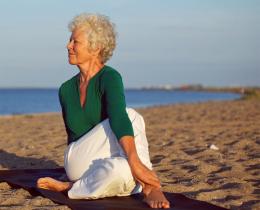The practice of Yin Yoga is a return to yoga’s ancient meditative roots. It’s a very simple practice and in its simplicity lies its quiet power.
There are two things that make a yoga asana more yin. First, the posture must allow muscles to relax. It is only when the muscles relax that we may access the deep yin parts of the body, the connective tissue. Perhaps most importantly, the asana must be done with an attitude of yin acceptance. To understand what this means, we must have some understanding of the Taoist concepts of yin and yang.
Yin Yoga Can Help Us Find Equanimity in Our Lives
Taoist tradition speaks clearly of the unity of all things. From the Tao—that place before and beyond duality—came the whole manifested universe, the realm of yin and yang. The polarities of yin and yang began when the universe separated from the Tao itself, at the time physicists call the big bang, the time when, from a Taoist point of view, all things came into being.
Yin and yang exist only because of one another. Without yin there would be no yang; without yang there would be no yin. Without up, there is no down. Without joy there is no sorrow; without sorrow there is no joy. Without life there is no death; without death there is no life. Without you, there can be no me. The relationship of yin and yang reveals the truth of interconnectedness.
Yang is our more masculine, aggressive nature while yin is our softer, feminine, more accepting self. By setting an intention in our practice to nourish this gentler part of ourselves, we can begin to soften, and be with what is happening in our bodies.
We can practice a simple posture, such as a seated forward bend, in either a yang or yin way. If we decide that there is a “right” way to do the posture, then we will adapt a yang attitude and strive to be “right.” We might take hold of our toes and use our muscles to pull us deeper into the pose. This can be helpful if we want to stretch our hamstrings, but it can also encourage any feelings we have that we’re not enough, that we should be different. To do this posture as a yin posture, we will bring to it an attitude of nourishing acceptance.
Rather than trying to force ourselves to look like someone else’s idea of what the posture “should” be, we can let our own bodies guide us. By not forcing or striving, our body will find its own natural pattern. Once we have allowed the body to find its own way into the posture, we invite it to stay there, generally for around five minutes. During this long hold, we are able to just be with what is. It is not a time to control either the mind or the body, but a time to witness everything that comes up.
The human nervous system operates within two basic systems: the somatic and autonomic nervous systems. The somatic system responds to our free will, and is the way we control our body's movements and functions. The choices we make are carried out by the somatic system. When we decide to move, it is the somatic system that makes it happen. This is the more yang aspect of our nervous system. The autonomic system operates by itself. It knows what to do to keep us functioning, by controlling such systems as heart rate, digestion, respiration, and circulation.
Within the autonomic system are two divisions: the parasympathetic and the sympathetic. The sympathetic system controls our “fight-or-flight” response. When we feel unsafe or threatened we automatically move into our sympathetic system. When this happens, a number of physical changes in the body take place in order to best prepare us to fight or run. The blood pressure rises, the immune system is modulated, the digestive system shuts down, and blood is sent to the big muscles of the legs. This puts a strain on the body, which is necessary for its survival, but which can have detrimental long-term affects. The feelings of danger might emerge from immediate threats: a lion charging, a car heading toward us in the wrong lane, or layoffs at work. They can also be the stories of past dangers or threats that may no longer be current, but remain with us nevertheless. Strong deeply seated memories can keep us stuck in this feeling of vulnerability.
The parasympathetic system is where we go to rest and renew ourselves. It is the natural state of the nervous system, when we feel safe in our lives. It is where we can feel that our life is in balance.
The Buddhist tradition speaks of the four divine abodes: lovingkindness, compassion, sympathetic joy, and equanimity. In my experience, the state of equanimity comes through the understanding that it is possible to be happy with things just as they are. It is the knowing in our mind and in every cell of our body that there is a place of balance in ourselves and in the cosmos where peace and joy exist, and that that place is available to us all. It is the understanding that the Tao is not something outside ourselves, but that it is who we truly are.
For us to feel compassion, lovingkindness, and sympathetic joy, we must have some equanimity in our lives. The Taoists think of this in terms of the balance of yin and yang. Until we can feel some peace in our lives, some balance, it’s very hard to feel compassion, kindness, or joy for others. It’s especially difficult to feel compassion and acceptance toward ourselves.
Equanimity is not possible when we are stuck in our fight-or-flight response and every effort is aimed at survival, at making it through another day. Yin Yoga can help us make the shift from fight to reconciliation, from flight to restoration, and from fear to peace.
Yin Yoga Can Help Us Release Deeply Held Trauma
From a physical point of view, yin practice is unique. If we look at the human body, we can see—as with the whole universe—that there are aspects of the body that are more yin, and aspects that are more yang. Yang is represented by the more striving parts of our physical being—the muscles; yin is held by our more accepting, less active parts—our connective tissues.
Connective tissue takes on many different forms within the body. It is the tissue that holds the bones together, holds the muscles to the bones, and keeps the internal organs in place. It is the web that forms and connects all aspects of the human body. The connective tissue has its own intelligence and memory. It is listening to and remembering our every thought and experience.
Much of the trauma we carry is held not just in the mind, but also in the body itself, most specifically in these deep connective tissues. Just as yin never exists without yang, trauma never exists without healing. Where the trauma is held in the body, there also is the healing. By allowing the muscles to relax, and our physical and emotional attention to focus on the body’s deep connective tissue, we can begin to release this trauma and access the healing that is our natural state.
Yin Yoga can work in much the same way as acupressure, Thai massage, and Rolfing, by helping access and release the old stories that our cells are holding. When we are able to listen to these deeply held memories, without blame or judgment, we create a space for learning and for healing.
As the poet Kabir suggests:
So let your body speak for you now, without you saying a word,
Like the student walking behind the teacher says
This one knows better than I the way.
The Yoga of Reconnection
The practice of Yin Yoga is a practice of reconnection. The Sufi poets speak of the source of our human sorrow being our disconnection from our source. We are the lonely reed that has been plucked from the reed bed. This sweet loneliness is a normal part of the human experience. This longing for reconnection opens our hearts.
When events occur in our lives that are beyond normal human experience, events that are so horrible we have no way to integrate them into our concepts about life, we have no choice but to disconnect. We disconnect from society, our family, our body, and our own heart. No place seems safe.
Yin Yoga is a way to begin to reconnect. It starts by helping us reconnect with our body. Accepting ourselves as we are is the first step. Allowing ourselves to be in the posture just as we are is a way of acknowledging our body and its wisdom. When a small child needs our attention, we first have to acknowledge the child.
By taking the time to sit down quietly and listen to a child or to our own body, we can connect. In the quiet of the yin postures, we can create a space for the body to feel safe. The small child within us can crawl out from under the bed and begin to reconnect with all the aspects of life from which it has been hiding.





